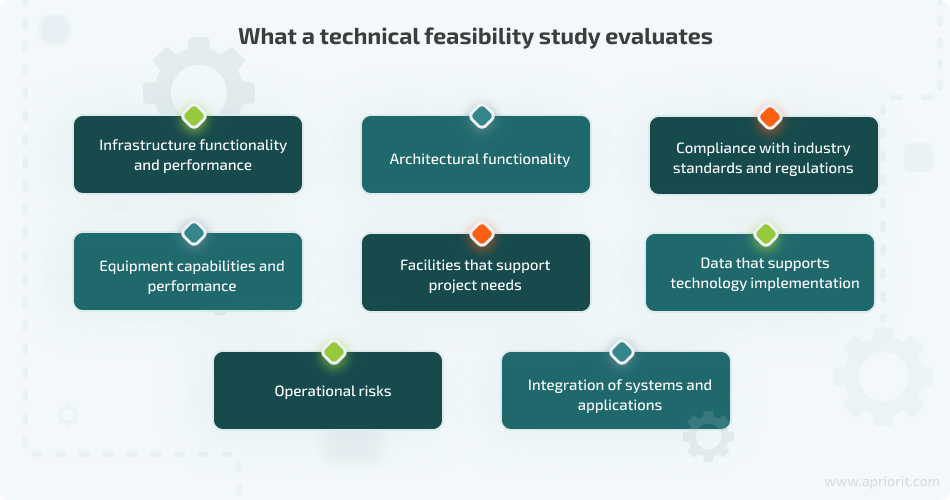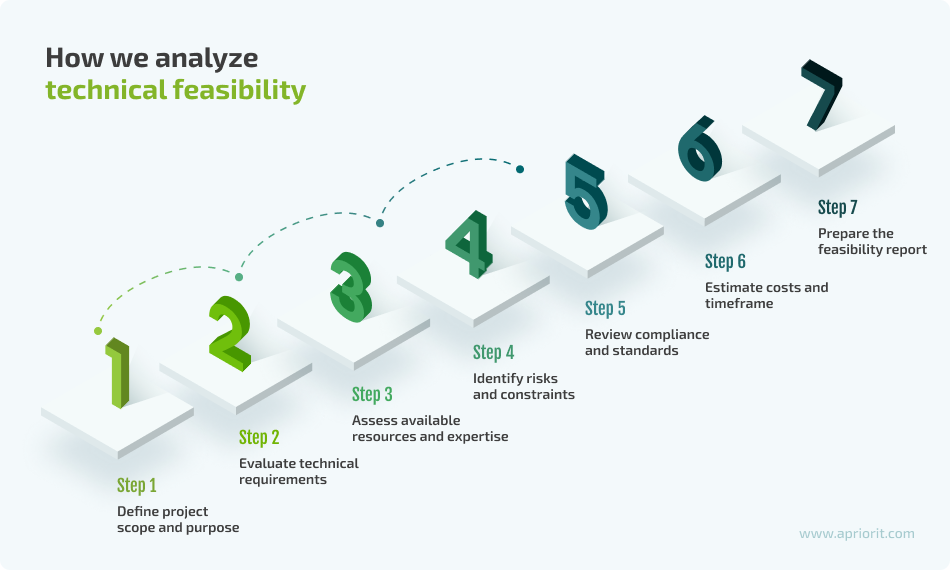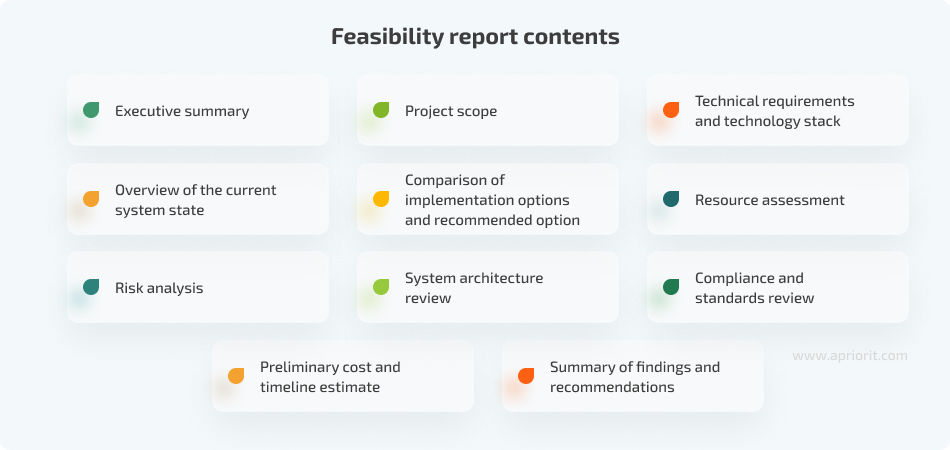Whatever software project you have in mind, you should ensure your idea is realistic before rushing into development. That way you won’t run out of resources before your project is complete and will be able to minimize time- and budget-related risks.
A proven way to assess the potential of your project idea is by running a technical feasibility analysis. This step helps you make sure that your project is technically viable and that your team can successfully implement it with the available technology, tools, methods, and resources. Moreover, technical feasibility uncovers potential technical challenges that could hinder your project’s success, allowing you to address them early.
In this article, we talk about why a technical feasibility study in software engineering is crucial. You’ll learn how this essential step can help you avoid common pitfalls, from unexpected technical limitations to resource constraints, ensuring that your project is set up for success from the very beginning.
This article is particularly valuable for project managers, developers, and IT leaders looking to minimize risks, optimize resource use, and establish a solid foundation for their software development projects.
What technical feasibility is and why it matters
What is feasibility?
Feasibility is the assessment of how practical and achievable a project or idea is, considering various factors such as resources, time, cost, and potential challenges. Assessing feasibility involves evaluating whether a proposed plan can be executed successfully and whether the expected outcomes are attainable.
There are many types of feasibility studies in software engineering that determine:
- Technical feasibility
- Economic feasibility
- Legal feasibility
- Operational feasibility
- Scheduling feasibility
In this article, we focus on technical feasibility, as it’s one of the most important and complex types of feasibility to analyze.
What is technical feasibility in software engineering?
Technical feasibility shows whether a proposed software project can be successfully developed and implemented with the available technology, tools, and resources. To assess technical feasibility in software engineering, you need to perform a feasibility study, which can also be called a feasibility analysis. It evaluates the practicality of the project’s technical aspects, such as the system architecture, hardware and software requirements, technical expertise, and integration with existing systems.
A technical feasibility analysis allows you to identify technical challenges such as:
- Scalability issues
- Integration challenges
- Technical debt
- Resource limitations
- Compliance and security risks
- Performance bottlenecks
- Cost overruns
- Technological obsolescence
By identifying potential technical issues early, you can ensure your project is realistic and achievable, reducing the risk of failure during development.
Set up your software project for success from the start
Let us help you build a solid foundation for your development project, minimize risks, and make the most of your available resources.
What does a technical feasibility study assess?
A technical feasibility study assesses a range of factors that determine whether your team is able to successfully deliver a software project. These assessments help to identify potential obstacles and make sure that the project can be carried out as planned.
Key aspects that a technical feasibility study evaluates include:

- Infrastructure functionality and performance — Existing IT infrastructure should be able to support the new software’s requirements without compromising performance.
- Architectural functionality — The system architecture should suit the project’s needs and accommodate future growth.
- Compliance with industry standards and regulations — The proposed solution and all its technical components like platforms, libraries, and tools should meet relevant legal and industry-specific standards and regulations.
- Equipment capabilities and performance — Hardware and other equipment needed to support the software should be able to handle the project’s demands.
- Project support facilities — Physical and technical facilities should be adequate to support the software’s development and deployment.
- Implementation data — Required data should be available, reliable, and suitable for the new system.
- Operational risks — Define operational challenges that could arise during or after implementation and consider how they might be mitigated.
- Integration of systems and applications — The new software should be compatible with existing systems and applications for seamless integration.
A technical feasibility analysis allows you to have a 360-degree view of your future project from a technical standpoint and thus plan your development process. But what does it actually mean for your business success?
What are the benefits of conducting a technical feasibility analysis?

- Early identification of potential problems. By uncovering technical challenges before development begins, you can proactively address issues, avoiding costly setbacks and ensuring smoother project execution.
- Efficient resource allocation. A technical feasibility analysis helps you accurately determine the resources — such as time, money, and expertise — needed for the project, allowing for better planning and efficient use of business assets.
- Match between technical solutions and project needs. The analysis evaluates if the chosen technology stack and technical requirements align with your project goals, leading to a more effective and successful implementation.
- Reduced risk of failure. By thoroughly evaluating technical aspects, you can ensure the project is realistically achievable, reducing the risk of failure and increasing the likelihood of delivering a product that meets business objectives.
As you can see, analyzing technical feasibility can help you improve your planning and increase the chance of your project’s success. But is it always necessary? Let’s discuss in what cases you need to assess your project’s technical feasibility.
Read also
How to Choose the Right Software Development Methodology for Your Project
Explore the strengths and weaknesses of various methodologies to find one that aligns with your project goals and team dynamics.

When do you need a technical feasibility analysis?
A technical feasibility analysis is part of the preparation stage of a software development project. It helps you to answer questions that are essential at the start of any major software development project. They include:
- Is it possible to develop the product with available technology?
- Do you possess the necessary expertise to complete the project?
- What budget is suitable for the project? What other resources will you need?
- Does the available technology align with your idea, timeline, and budget?
A feasibility analysis is especially relevant in the following cases:
- New product development. Before developing a completely new product, you need a technical feasibility study to check if your idea is technically possible and sustainable. This is especially important if you have never created a product of this particular type.
- Major system upgrades and integrations. If you plan to significantly revamp your product or add a major part to your existing software, a feasibility study will help you assess whether your new functionality or product is compatible with your current infrastructure.
- Adoption of new technologies. If you want to power your software with cutting-edge technologies like AI, the blockchain, or cloud computing, you can use a technical feasibility study to find out if they fit your use case and if your current system is compatible with them.
- Large and resource-intensive projects. It’s vital to make sure that all technical aspects are thoroughly assessed and all resources are effectively allocated for projects involving complex, large-scale implementations with multiple stakeholders and significant investments.
- Highly regulated industries. If you create software for an industry with strict compliance and regulatory requirements, you can check whether your product meets all regulations, laws, and standards (such as the GDPR in the EU and HIPAA for healthcare in the US), thus avoiding legal risks and reputational damage.
Are there any circumstances when you don’t need a feasibility study in software engineering? Yes. Here they are:
- You’ve already worked on this type of project in recent years and know how long it usually takes to develop, as well as the risks and benefits for the business.
- Your project is rather small and simple and won’t significantly affect the business or require heavy investment.
Now, let’s look at how we approach technical feasibility analysis at Apriorit to answer these questions for our clients and deliver projects according to their requirements, resources, and constraints.
Read also
Business Analyst’s Roles & Responsibilities in Software Development
Enhance efficiency, reduce costs, and drive strategic decision-making by involving professional business analysts (BAs) in your project. Explore a BA’s roles, responsibilities, and benefits in our guide.
How to analyze technical feasibility: Apriorit’s approach
Technical feasibility analysis involves several key steps that we carefully tailor to each project’s specific needs and challenges. The exact process can vary depending on the industry, the complexity of the technologies involved, and the client’s unique requirements.
At Apriorit, we’ve built our technical feasibility analysis process in a way that guarantees accurate results and reflects the project’s real-world conditions. Let’s look at our process in detail.

Step 1. Define the project’s scope and purpose
The first step in conducting a technical feasibility study is to gather the information you gained during the discovery phase. This is the initial stage during which we gather all important information about the project, including your goals and desired outcomes; the project’s scope, requirements, and constraints; and key stakeholders’ requirements and concerns.
Step 2. Evaluate technical requirements
During the technical feasibility study, we focus on eliciting high-level functional and technical requirements, including features, performance expectations, and user needs. We also determine the technology stack, tools, and platforms that we’ll use to build the project and carefully decide if they are compatible with its needs.
If we work on an existing project, we will also evaluate the existing infrastructure to ensure it can support the new functionality or technology. This includes analyzing hardware, networks, databases, and other systems.
At this stage, we will also evaluate alternative solutions or technologies that could be used to achieve the same goal. This will help us choose the most suitable and cost-efficient strategy for our technical implementation.
Step 3. Assess available resources and expertise
After we’ve identified your technology stack, we offer you a team of specialists with sufficient skills and knowledge. Apart from that, we evaluate other resources like finances, equipment, and time.
If you plan to build your project using an in-house team, you should assess their technical skills. If you find any gaps, you can always hire a dedicated team with specific expertise.
Step 4. Identify risks and constraints
Any feasibility study should contain risks and constraints because they may affect both the time and budget for development. Here are some potential risks that are common for software development projects:
- Issues with third-party integrations
- Maintenance issues
- Scalability issues
- Lack of technical expertise in the team or on the market
- Lack of support for new technologies
- Compatibility issues with existing software
- Difficulties with implementing new features in the long run
- Inflexible infrastructure
At Apriorit, we include potential strategies and solutions to address identified risks, prepare the team, and adjust your expectations.
Step 5. Review compliance and standards
As part of your feasibility study, we assess whether the project meets all relevant industry standards, legal requirements, and regulatory compliance requirements, especially if your business operates in a highly regulated industry. We check if it is possible to implement your project according to all regulatory requirements within your budget and timeframe.
At Apriorit, we emphasize industry and security standards to ensure your software maintains your business’s safety and reputation.
Step 6. Estimate costs and timeframe
At this stage, we:
- Develop a realistic project timeline considering the project’s complexity and available resources
- Identify key project milestones
- Estimate the total cost of the project so you can compare it with the available budget
Detailed timeline and budget estimates are typically more comprehensive elements of the discovery phase. However, at Apriorit we include preliminary or high-level estimates in our technical feasibility report, as they are closely tied to the project’s technical viability.
Step 7. Prepare the feasibility report
After we gather all information, we compile the results and create a detailed report that outlines the technical feasibility, identified risks, proposed solutions, and cost estimates.
After the report is ready, it should be reviewed by major stakeholders, including the project manager, as well as by business and technical leaders. Based on their analysis, you can decide whether to proceed with the project as is, make adjustments, or halt it.
Let’s now discuss the feasibility report itself and the course of action you should take after you receive it.
Read also
How to Reduce the Time to Market and Release Digital Products Faster
Get a first-mover advantage over your competition. Learn how to accelerate your software development process and reduce time to market effectively.

How Apriorit can help you with a technical feasibility analysis
In over 20 years of our work, we have conducted many technical feasibility analyses that have allowed our clients to confidently move forward with complex projects knowing they were built on a solid technical foundation.
Our deep technical expertise guarantees that every project is thoroughly evaluated for its viability, scalability, and security, minimizing risks and preventing costly setbacks.
As a result of Apriorit’s technical feasibility analysis, you’ll receive a comprehensive report that gives you a 360-degree view of your project, its scope, its implementation strategy, and required resources.
Here is an example of the structure of a technical feasibility analysis report.

After completing a thorough technical feasibility analysis, Apriorit can continue to support your project by taking insights gained and translating them into actionable steps. Here’s how we can help you move forward:
- Develop the proposed solution. Based on the feasibility study’s recommendations, we can develop a full-scale software solution that meets your business needs. Our extensive pool of 400+ engineers will allow you to get a skilled team to cover any technical requirement your project entails, from low-level driver development to artificial intelligence, machine learning, and blockchain development.
- Conduct feasibility testing. To validate the feasibility of specific aspects of your project, we can develop a prototype or a proof of concept (PoC). This will allow you to test key functionalities and technical components in a real-world environment, helping to refine the project before full-scale development begins. This will allow you to reduce uncertainty and make more confident decisions moving forward.
- Minimum viable product (MVP) development. If your project involves launching a new product or entering a new market, Apriorit can develop an MVP with the core features necessary to gather user feedback and validate the product idea. This will allow you to test the market and make decisions for future development based on real-world data.
- Technical consulting and support. As your project progresses, we help you navigate emerging challenges, optimize the solution, and ensure that the project stays aligned with your long-term goals. Our team is always available to address any technical questions, perform updates, and bring your software project to success.
By partnering with Apriorit, you get a feasibility analysis and a reliable development partner who can bring your project from concept to reality, ensuring that it delivers maximum value to your business.
Related project
Evaluating Smart Contract Security for Decentralized Finance (DeFi)
Explore how Apriorit performed an in-depth smart contract audit and provided recommendations on mitigating uncovered risks to ensure flawless security and help the client maintain a reliable reputation and customer trust.
Conclusion
Before investing in a software project, it is essential to make sure it will bring real value to your business. One efficient way to evaluate your idea is to conduct a professional technical feasibility study.
A feasibility report provides a crucial assessment of whether a software project is technically viable, helping you make decisions before fully committing to development. It identifies potential technical challenges, evaluates resource requirements, and aligns your project with business objectives.
Our dedicated team of experts will help you identify even the most unobvious risks and prepare for them so that you can be sure you get a scalable, reliable, and secure product that will help your business grow for years to come.
Need to validate your project idea with technical experts?
Make sure your development efforts are aligned with your goals. We’ll help you evaluate the project’s technical requirements, identify potential obstacles, and assist with other engineering tasks.




